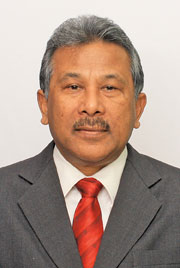Malaysia has long been a haven for high-tech companies, with several maintaining operations there for decades. They are staying in Malaysia to take advantage of the country’s forward-thinking approach to keeping these companies from relocating elsewhere in the region. Malaysia’s prime location in Southeast Asia midway between the booming Indian and Chinese markets and extensive ports and logistics infrastructure remain powerful draws.
But high-tech companies are remaining and expanding because of Malaysia’s increasingly attractive intellectual property (IP) climate and its drive to cultivate R&D and other knowledge-intensive activities in its IT sector. Both efforts will advance Malaysia’s efforts to transition to a high-income economy — one that will benefit Malaysian society and the high-tech companies that invest and expand there. IBM and National Instruments are two cases in point.
“Malaysia has had a favorable investment policy since the 1960s that has enabled the country to ensure sustained growth over the last few decades,” says Craig Tucker, director, IBM Global Delivery Centre Malaysia. “The country’s multi-sector economy, along with rich natural resources, has helped it become an attractive investment destination for organizations across the globe. IBM, for example, started its operations in Malaysia way back in 1961, and is among the pioneering IT organizations in Malaysia.” The IBM Global Delivery Centre, in Cyberjaya near Kuala Lumpur, is part of a network of service delivery centers in more than 20 locations worldwide. Inclusion of Malaysia in this network demonstrates the country’s successful transition to higher-end IT activities — a transition IBM has been present to witness firsthand.
“In the mid-1990s, the Malaysian government launched the Multimedia Super Corridor, shifting the gears from factory-line assembly operations to talent and intellectual property development,” Tucker explains. “In the context of IP protection, it is an area that has gained recognition and value. The Intellectual Property Corp of Malaysia (MyIPO) was established for those who want to protect a design, trademark or patent. These initiatives have helped create a strong and sustainable environment for innovation and invention in the country.”
IBM invests over US$6 billion in R&D per year, notes Tucker. “We are excited to see Malaysia actively engaging to protect intellectual property in its quest to draw more R&D operations.” In 2008, IBM set up a software development lab in Malaysia as part of its global research, development and business strategy, he illustrates. “The engineers at the lab are developing industry applications for our Tivoli suite of products for some of the leading companies across the globe and for organizations in Malaysia.”
Tucker cites talent, location, government support and infrastructure as the main drivers of IBM’s growing presence in Malaysia over the past 50 years. “The country has a large supply of IT expertise and multilingual talent,” he elaborates. “The shared service centers support 11 languages from Mandarin to Korean to Spanish.
“Malaysia is strategically located to cater to different time zones and is coupled with attractive government incentives to set up shared service centers. The government has a strong focus on the growth of the technology sector in the region and is also keen on creating successful public-private partnership models, and it has made significant investments to create world-class infrastructure, especially in areas like data and voice networks, telecommunications and transportation.”
Penang Secures an R&D Center
National Instruments (NI), a global technology company that began operations in Malaysia in 2009 with an $80 million capital investment, announced plans in July for a significant expansion of its R&D center in Penang. The expansion will bring the center to 314,000 square feet. Over the next five years, NI plans to recruit 250 engineers in the Penang R&D center in electrical, mechanical and engineering management.
Once completed, the expansion will make NI Penang the largest R&D center for National Instruments outside of its headquarters in Austin, Texas. National Instruments provides engineers and scientists with software and hardware to meet any engineering challenge, including test, measurement, control and embedded design applications.

“Our site selection process was based on quantitative and qualitative models,” says Raj Purushothaman, managing director, National Instruments Penang. “The quantitative model focused on the total cost of operations over a period of 15 years. The qualitative model was based on extensive factors based on the following criteria: business environment, infrastructure, availability of talent, political and economic stability, presence and track record of high-tech industries and standard of living. We started with a list of 20 countries around the world. After the exhaustive process mentioned above, combined with site visits, we picked Penang, Malaysia.”
Scott Rust, NI’s vice president of R&D, cited the Malaysia-specific factors that brought this investment to Penang: “Malaysia’s highly talented and creative work force, excellent university system, cost-competitive environment and strong support from the government match well with our global R&D growth plan and help us accelerate the introduction of new and innovative products to meet our customers’ needs.”
Malaysia has a strong record with respect to high-tech companies, adds Raj Purushothaman, pointing to a 40-plus-year history of hosting electronics and other IT operations. “Our research shows that the IP laws in Malaysia are on par with global standards,” he notes. “More and more companies are setting up R&D activities. Our investment involves a significant investment in R&D. However, Malaysia needs to invest more aggressively in science, technology and engineering education to continue to attract more R&D investment.”
Trade Pact Would Span the Pacific
Intellectual property rights are among the elements being addressed in trade negotiations to which Malaysia is a party, particularly the Trans-Pacific Partnership (TPP), a free trade agreement initiative involving nine countries, including the U.S., Peru and Chile in the Americas and six in the Asia-Pacific region. Malaysia, as part of the 10-member Association of Southeast Asian Nations, already enjoys free trade agreement status with China, South Korea and Japan. It is in bilateral discussions to pursue FTAs with New Zealand, Turkey and Pakistan. But a successful conclusion to TPP negotiations, now in their second year, will broaden Malaysia’s free trade reach across the Pacific and into Australia and New Zealand with deeper commitments to several key areas than existing FTAs stipulate.

“The Trans-Pacific Partnership will help to ensure that Malaysia remains a key link in the Asia-Pacific supply chain and an attractive investment destination and production hub for value-added products.”
“The TPP is an initiative to establish a comprehensive, high-ambition, next-generation FTA which will encompass both elements of a traditional FTA and also new areas, such as government procurement, competition, IPR, labor, the environment and horizontal issues — regulatory coherence, competitiveness and business facilitation, development and SMEs,” says J. Jayasiri, senior director, Ministry of International Trade and Industry, Multilateral Trade Policy and Negotiations.
“It builds upon traditional FTAs by enlarging the scope and deepening the level of commitments. As a major step forward, the TPP also deals with current issues in trade and investment, such as those that deal with the supply chain, regulatory coherence and SMEs that have often been overlooked in past FTAs. We have always assumed that with increased market opportunities, SMEs would quickly take advantage of FTAs and be able to move beyond their existing capacity. This, unfortunately, has not always been the case. Malaysia looks to the TPP not only to create the market opportunities but to go one step further and provide the window to enhance SME integration into the global supply chain.”
Jayasiri says the TPP will facilitate the development of supply chains across the Asia-Pacific region. “Through a mechanism that will continuously monitor and review its development, we hope to deal, in a constructive manner, with issues that arise behind the borders which have in the past been difficult barriers to trade.” Members will be encouraged to institute internationally accepted Good Regulatory Practices in formulating rules and regulations that affect trade. “This will have a significant impact on the cost of doing business and ensure that the business environment remains conducive.”
TPP represents a single market of almost a half billion people with the potential to increase its reach further once other APEC economies join in. Canada is scheduled to join TPP negotiations in December.
“Since the TPP is viewed by many as a precursor to a wider FTA for the Asia-Pacific region, it could potentially constitute a market of 2.7 billion,” notes Jayasiri. “For Malaysia, the export potential is huge. It will also enable Malaysia to engage the U.S. — a major trading partner and a significant source of investment — for which we do not yet have a preferential trading arrangement. With the TPP, an additional 10 percent of Malaysia’s global trade will be accorded preferential treatment bringing the total preferential trade to around 70 percent of Malaysia’s global trade. Malaysia can also expect inflow of investments from countries that want to use Malaysia as their base to penetrate other TPP markets. The TPP will help to ensure that Malaysia remains a key link in the Asia-Pacific supply chain and an attractive investment destination and production hub for value-added products.”
Well Positioned for the Future
Malaysia is an active and leading participant in TPP, ASEAN and other free trade agreement initiatives, which is serving it well today and will do so for years to come.
“Malaysia is fundamentally a trading nation,” observes Marc Mealy, vice president, policy, at the US-ASEAN Business Council, an advocacy organization for U.S. companies doing business in the ASEAN member countries. “The fact that with fewer than 30 million people it’s a top 20 global trading nation in the world speaks volumes about the role that trade plays. Multinationals doing business in Malaysia as part of their global business strategies, or at least their Asia business strategies, is a longstanding characteristic of Malaysia. How do you maintain your regional or global competitiveness and attractiveness as a place for global investors to establish operations? Part of the answer is to use trade policy and free trade agreements to do that.”

“Being in Malaysia will be very advantageous for any global company as these architectures evolve over time.”
Mealy says Malaysia served as the leader of ASEAN in negotiating an economic cooperation agreement with India. “We’ve seen examples of multinationals with operations in Malaysia or a neighboring country use those resources and that agreement to tap into the Indian market, a market with policies that can make it challenging for companies to access their market.
“These trade linkages via FTAs or regional economic partnership agreements really do provide an additional source of competitiveness, letting Malaysia say to any company in the world that this is the place you would want to be if you want better access to these well established and growing markets in the Asia-Pacific region. Malaysia knows there is no way it can have the national economy and standard of living it has without being part of the global trading system, and for multinationals to see Malaysia in that context. Trade policy and the use of FTAs is a fundamental element in the country’s national economic development growth strategy. As the world has changed, Malaysia has evolved its trade policy.”
How Service Sectors Will Benefit
One example is the growing importance of using free trade agreement provisions to support Malaysia’s growing services sector. Mealy explains: “Within the toolkit of trade policy has been domestic economic policy, including industrial development and, in more recent years, a focus on services sector development, culminating most recently in Malaysia’s economic transformation agenda. Where the intersection occurs between the FTAs and trade policy and the economic transformation agenda is that many of the reforms Malaysia is doing on their own under the Economic Transformation Plan are actually initiatives that are identical to or consistent with or reinforce the same types of changes they are making when they do trade agreements. That’s the synergy between the two.
“Malaysia has taken steps to liberalize the services sector of its economy,” Mealy adds. “When they are negotiating a free trade agreement, let’s say with the EU or the TPP, the negotiations are going to create commitments for all members of the negotiations to liberalize service sectors. The things they have done on their own, which multinationals already benefit from, are the same things they would be asked to do as part of the TPP. U.S. companies already get the benefits of these opportunities before TPP is even finished.”
American insurance companies, for example, have made major investments in Malaysia lately, because the government changed the laws to allow for more foreign investment. For any insurance company around the world looking for growth opportunities, Malaysia and Southeast Asia stand out in terms of growth, Mealy points out. “Malaysia has easily attracted about $300 million in foreign investment in the insurance sector. Similar things are being done in other financial services. Services across the board will become a larger share of the Malaysia national economy over time, as manufacturing becomes a smaller part of GDP.”
Meanwhile, still another regional trade agreement initiative is taking shape, and once again Malaysia is in the middle of its formation (a successful conclusion to TPP negotiations is not guaranteed).
“Malaysia is in a unique, can’t-lose situation,” Mealy notes. “Japan, China and India are not part of TPP. Any global company worth their salt will tell you those markets are important. The fact that TPP is moving so quickly, and they are not part of it, is a reason why there is another potential FTA agreement initiative now getting under way that could become both a compliment and rival to TPP. It’s called the RCEP — Regional Comprehensive Economic Partnership — and is based on a framework developed by Malaysia and its nine neighboring ASEAN countries. While Malaysia is a member of TPP, it’s also a member of the RCEP, for which negotiations could get under way in 2013. At its core, it seeks to harmonize the big free trade deals ASEAN already has in place into an overarching agreement — affecting ASEAN’s agreements with China, Korea and Japan.”
In November at the East Asia Summit the heads of state of the 10 ASEAN countries will meet with the heads of state from eight other nations including their ASEAN Plus Three partners China, Japan, and Korea, along with India, Russia and the U.S. “You can bet in some of those conversations, this RCEP initiative will be discussed,” says Mealy. If the heads of state from interested nations were to agree to it, they could give a mandate to their trade ministers to start negotiations in 2013. Such a scenario could lead to the formation of two trade liberalization initiatives in Asia. While the TPP has emerged as America’s primary game in terms of engaging Asia, Malaysia is in great shape, because it’s in both.”
Major differences remain among the members of TPP negotiations in key areas and one cannot predict the outcome of these negotiations. Mealy says RCEP will likely have a broader appeal to some Asian economies, because of China and India’s likely participation and lower barriers to entry for Asian Less Developed Countries to participate. “Malaysia is in both frameworks, so they have a nice hedge regardless of what happens. Being in Malaysia will be very advantageous for any global company as these architectures evolve over time.”
This Investment Profile was prepared under the auspices of the Malaysian Investment Development Authority. For more information, visit www.mida.gov.my.
